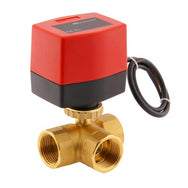Collection:3-Way Electric On/Off Brass Ball Valves
Explore Tameson's wide range of 3-way brass electric ball valves from various global manufacturers. 3-way electric ball valves, also called 3-way motorized ball valves, are used to control the f... Read more
3-Way Electric On/Off Brass Ball Valves

Explore Tameson's wide range of 3-way brass electric ball valves from various global manufacturers. 3-way electric ball valves, also called 3-way motorized ball valves, are used to control the flow of a media (liquid or gas) by means of a rotating ball with a bore. The rotating ball is controlled by an electric actuator that connects directly to the ball valve stem, rotating it a quarter turn. A 3-way brass electric ball valve can be broken down into two main components, namely, the electric actuator (servo motor) and the ball valve. A 3-way ball valve has three ports. They are available in two design types: L-port and T-port. This refers to the bore design in the ball, which is the media flow path.
With a 3-way ball valve T-port or L-port, it is possible to mix, distribute, or divert the media flow. A 3-way T-port valve can be used for mixing media from two inlets into a single outlet or for distributing one inlet to two outlets. The 3-way L-port ball valve is designed for flow direction control. The L-port valve has a 90 degree bore inside of the ball, hence the name L-port. An example of an application is to have two inputs from separate tanks and one output, and you want to only use one of the inputs but always the one output. L-port ball valves can have 90 degree or 180 degree handles. Ones with a 180 degree turn allow you to disconnect both inputs from the output, allowing for no flow. Therefore, it is important to know your bore design to ensure your desired media flow, as the ports can be in different positions. The pressure inlet for 3-way ball valves is typically on the center borehole to avoid leakage unless defined otherwise in the product specifications. These motorized 3-way ball valves can be controlled remotely to switch between the circuits. If electrical voltage is already available, a 3-way control valve is a good investment to automate the process.
3-way brass electric valves are durable, with very less leakage over their lifespan, even if they have not been used for a long period of time. These valves can withstand high pressure, high temperature, and high flow rates. Brass is an alloy of copper and zinc and has great mechanical properties. These valves can be used for automating applications with drinking water, gas, mineral oils, compressed air, and many other non-aggressive media. But they are not suitable for use with salt water or distilled water due to the risk of dezincification. Dezincification reduces the mechanical strength of brass by causing the zinc to be removed from the alloy resulting in a porous structure. However, electric brass ball valves are more resistant to contaminated media compared to other types of housing material and provides reliable sealing even in the case of dirty media. They are also economical due to their simple and robust design, low cost, and low maintenance needs. Due to these advantages, 3-way electric brass ball valves are used in many residential and industrial applications.
Some common applications include controlling domestic hot and cold water systems, steam applications, irrigation systems, natural gas systems, marine industries, fire protection applications, and chemical industries. An actuated brass ball valve is a great way to automate these applications.
Tameson also offers a range of brass zone valves designed for use in HVAC systems, enabling energy-efficient temperature management across different zones.



